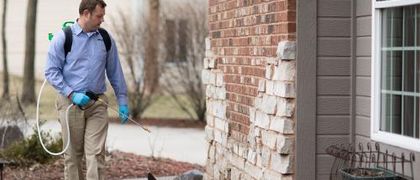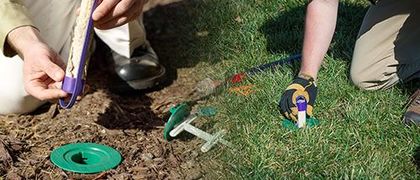What do yellow jackets look like?
- Size: 1/2 in.
- Color: Black and yellow striped
- Body Structure: Head, thorax, abdomen, stinger, and body-length wings

Characteristics of yellow jackets
Yellow jackets are social insects living in colonies. Colonies are comprised of sterile female workers, males, and fertile females that mate with males in the fall to become yellow jacket queens. Fertilized queens hibernate through the winter, whereas males and workers die as the weather turns colder.
When are yellow jackets most active?
What does a yellow jacket nest look like?
Yellow jacket nests aren't always easy to spot because they are often partly concealed. That said, nests are built out a paper-like material made from chewed wood fibers mixed with their saliva.
Where do yellow jackets build nests?
Yellow jackets often nest near the ground, taking over old nests and burrows made by rodents. These stinging insects may also construct nests in the walls of houses and other structures, under porches or steps, as well as in the branches of low-hanging trees or shrubs.
What do yellow jackets eat?
Yellow jackets feed on flower nectar and fruit, but they also like sugary treats and drinks. They're also scavengers that will consume refuse. Interestingly, the larval stage feeds on protein so insects and other types of meat must be brought back to them.
Are yellow jackets dangerous?
Yellow jackets are particularly aggressive in defending their colonies so having an infestation in or near home poses a threat the well being of your family and pets. What's more, yellow jackets are capable of inflicting multiple stings, which may only produce redness, swelling and pain at the inject site for some, while it can send others into anaphylaxis shock that requires medical attention.
Why do I have a yellow jacket infestation?
Yellow jackets are attracted to food sources including fruit, flowering plants, and sugary drinks and treats as well as garbage and other insects.
How do I get rid of yellow jackets?
If you've discovered a yellow jacket nest or noticed yellow jackets buzzing about on your property, contact an exterminator for help taking care of this stinging pest problem. Do not attempt to remove a yellow jacket nest on your own.
At Miller Pest & Termite, we offer stinging insect control services for yellow jackets, paper wasps, and hornets as well as other stinging insects. Reach out today to find out how our local pest control team can help you take care of aggressive yellow jackets!
How can I prevent a yellow jacket problem?
To make your property less attractive to yellow jackets, our pest pros recommend the following stinging insect prevention tips:
- Seal all openings on the exterior of the house, even tiny cracks
- Fill all rodent burrows and holes in the ground
- Keep sugary drinks and food covered when eating al fresco
- Clean and cover your grill after each use
- Do not feed pets outside
- Use exterior trash cans that have tight-fitting lids
- Change exterior lights to yellow bulbs
- Harvest your garden regularly and pick up fruit that has fallen off trees


Get Help Now!














